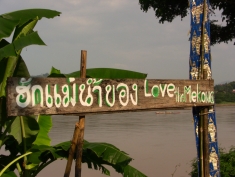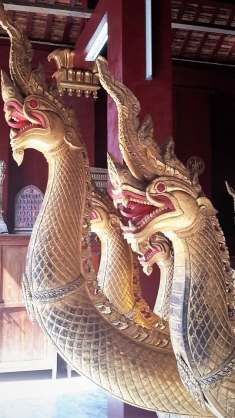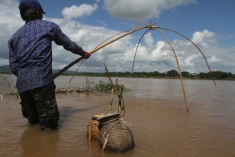A Visit to the Mother River
The small town of Chiang Khong in Northern Thailand sits on the banks of the Mekong River. Just across the river lies Laos; at night, the sound of local youths performing karaoke drifts across the dark waters, subtly infusing the dreams of their Thai neighbors.
The Mekong, which local people call their Mother River (or Mae Khong), is central to Chiang Khong’s way of life. Fish are everywhere: Their carved white marble statues dot the riverbank, and grace many guesthouses. In a local temple, golden fish embellish the main temple doors, as large as dragons. In one carving, a woman with a fish tail sits on the side of the river, braiding her hair as fishermen ply the waters.
Older people still know many of the 96 fish species that inhabit their stretch of the river, and are familiar with the pools, ponds, channels and currents which these fish visit at different times of the year. Over generations the local fisher folk have developed 57 different types of nets – each adapted to a specific fish, at a specific part of the river at a specific time of year.
The Mekong also provided water and silt to the sand bars and banks after the rainy season, and the farmers of Chiang Khong grew a rich harvest of soy beans, cabbage, lettuce, corn and other produce in these fertile seasonal gardens. People also knew where to find medicinal plants along the river banks.
Just ten years ago, scores of fishing boats would gather at the town’s pier at dawn, ready to head out for the day’s catch after they had paid their respects to the river’s spirits. As the sun rose, the sound of Lao’s civic announcements would echo, and cattle would wander out to forage on the islets mid-river.
No more. On a recent trip to Chiang Khong, the docks were empty. Not one fishing boat left the shore at dawn. Though the river serpents still watch over the Mekong at the Phra Kaew temple in Chiang Khong, the Mother River is suffering.
In the past 20 years, Chinese dam builders have blocked the flow of the river with seven large dams north of the Thai-Lao border. The dams have replaced the natural river flow with artificial water releases that fluctuate wildly and unpredictably. They are also holding back much of the silt that enriches the floodplains downstream.
These changes are upsetting the delicate balance of the river. The Mekong fish depend on the ecological cues that the natural flow has always provided for the stages of their life cycle, and many of them can’t cope with the new artificial regime. According to local researchers, the fish catch has declined by as much as 70% in many places.
The local river gardens are starved of much of the nourishing silt, and are eroded or swept away by the aggressive, silt-free water releases from the upstream dams. The farmers and fisher folk of Chiang Khong have seen their intimate knowledge of the local ecosystems, which they passed on for many generations, devalued. Needless to say they were never consulted about the dam projects that upended their lives, or compensated for their losses.
Now, the previously stable communities are breaking up. With no jobs and no way to make a living from the river, young people are moving to the city to work. Family ties are fraying as spouses take jobs – often far from home – as agricultural laborers.
As we found out when we continued our visit, the Mekong is still bountiful. It feeds and sustains millions of people further downstream as it follows its course through Laos, Thailand, Cambodia and Vietnam. The river is home to almost 600 fish species, and supports the world’s richest freshwater fisheries. Downstream of Chiang Khong, we saw numerous fishermen out on their plank canoes, using elaborate bamboo rods, fishing nets and funnel baskets that are adapted to the river’s changing features to bring in their catch.
But eleven dams are under construction or have been proposed to be built in Laos and Cambodia. If completed, these dams would turn the lower Mekong from a healthy river into a series of stagnant reservoirs. They would block the fish migration and, according to a report for the Mekong River Commission, reduce the fish catch from the river by up to 42 percent. These losses would most seriously affect the food security of the poorest people.
International Rivers will continue to support our friends in the Chiang Khong Conservation Group. With our partners in the Save the Mekong coalition we will continue to fight, delay and hopefully stop the proposed dams on the Mekong. Energy experts working with us have documented that better alternatives to meet the region’s electricity needs are available. But at stake is more than the megawatts for the desires of a growing Thai middle class.
The farmers and fisher folk of Chiang Khong have developed a way of life in balance with the ecosystems of the Mekong, which sustained them. In contrast, the dam builders and their allies have never been able to show a convincing alternative to the ecosystems, the nourishment and the spiritual identity that a healthy Mekong provides.





